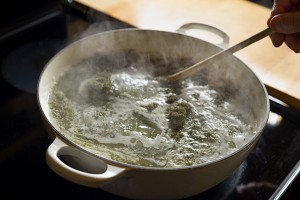Making either cannabis oil or cannabutter employs essentially the same process. I always have both in my house. The butter I keep in the freezer, and the oil in the fridge.
When planning to make canna oil for homemade weed edibles, you need to determine which oil you want to use. The oils I use most often are olive, coconut and canola.
THC is released into the oil during the heating process, and the oils with a higher fat content absorb the most THC from the plant. Olive and coconut have higher fat content than canola. However, they really should not be heated to a super high temperature. (Once the THC is in any oil, you need to keep the heat relatively low, no boiling allowed. See note at bottom).

I like to use butter and/or coconut oil for most desserts, and olive oil or canola for savory fare. That said, when making curries, I almost always use coconut oil. Canola oil has the mildest taste, and there are light olive oils that are not very fruity or strong. There is also refined coconut oil that has virtually no coconut taste. Another thing to consider is that a naturally strong-flavored olive oil or coconut oil will work to your benefit in terms of masking the taste of the marijuana.
Making cannabutter: Step-by-step instructions and photos to guide you through the process
The proportions for the cannabis oil that work best for me are to use one ounce of good weed trim, flower and bud, and 2 cups of oil. Follow the process used to make cannabutter, using water and being sure that there is at least a two-inch layer of water under the weed/oil mixture throughout the cooking process.
After spending the night in the fridge, I sometimes have to spoon the canna-oil off the top, as it does not form a solid disk.
Ingredients
2 cups oil
1 ounce potent marijuana
THC potency in edibles: A how-to on calculating the THC dosage for home recipes
Note: Boiling is said to decrease the THC potency. While I don’t have scientific evidence, I play it safe and always keep the oil on a very low heat (with the occasional bubble or two), but not a complete simmer. Do all searing and cooking that requires high heat with plain oil.
If there is a dish that requires high heat, such as a stir fry, separately saute with canna-oil one of the components to get the weed in the food, and add that component shortly before serving.
How do you consume your cannabis? Product reviews from Firefly, O.penVape, Sasquatch Glass, Timberado, Grenco Science and more. Want your gear reviewed? Submit your glass, vapes and more: cannabistcritics@gmail.com.
Now that you know how to make canna oil, here are some guides to cooking with it:
– How to make cannabutter and cannabis oil concoctions: the ultimate guide with tons of tasty weed recipes
– How to safely try cannabutter or cannabis oil when you don’t know its THC potency
